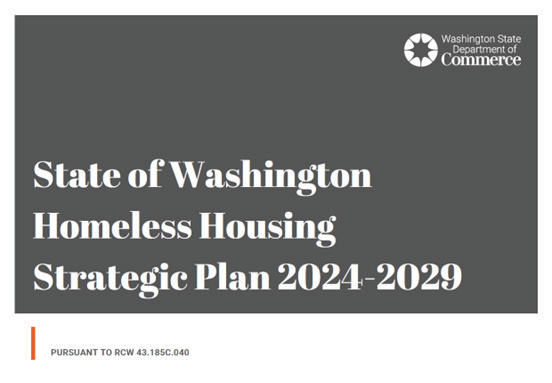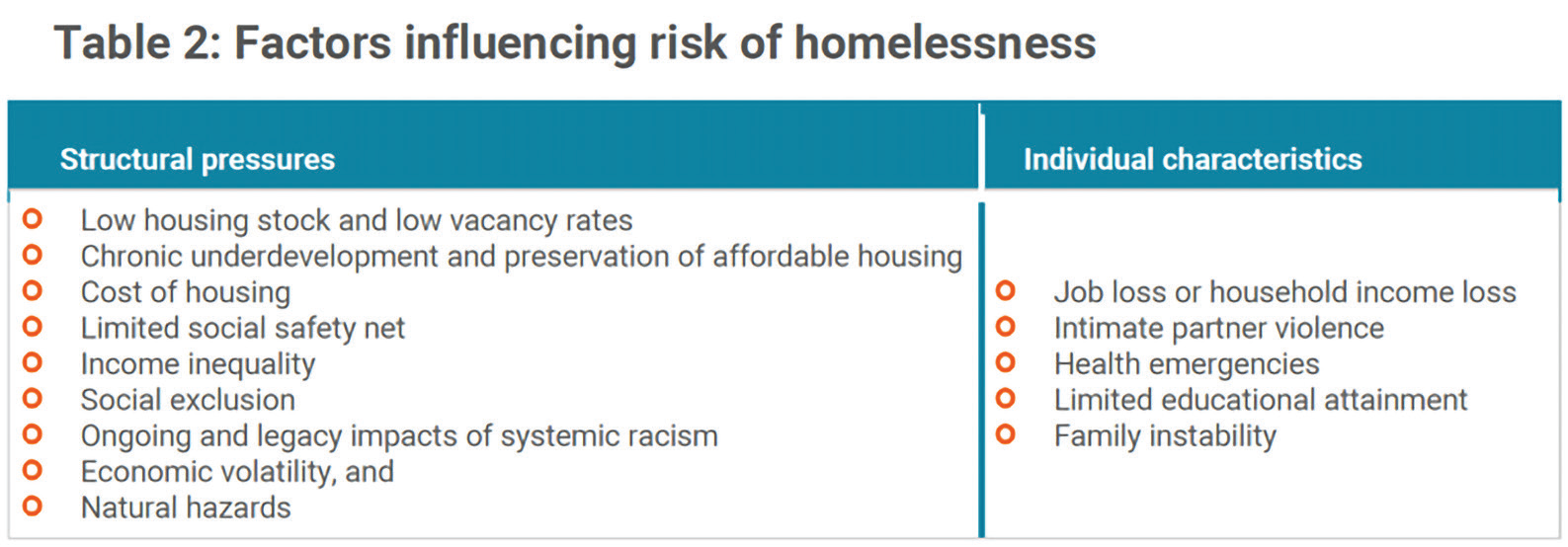ROBERT CONQUEST VS THE WASHINGTON STATE DEPARTMENT OF COMMERCE

Robert Conquest, a renowned historian and political commentator, is best known for his work on Soviet history and totalitarian regimes. Conquest is perhaps most famous for his three rules of politics, which explain the nature of bureaucracies and government institutions:
- Everyone is conservative about what they know best.
- Any organization not explicitly right-wing sooner or later becomes left-wing.
- The simplest way to explain the behavior of any bureaucratic organization is to assume that it is controlled by a cabal of its enemies.

Conquest’s third rule perfectly captures the dysfunction of the Washington State Department of Commerce, especially in its 2024-2029 Homeless Housing Strategic Plan (hereafter referred to as The Plan). The Plan describes specific actions the Department of Commerce will take over the next five years to reduce homelessness and lay the groundwork for building 1.1 million units over the next 20 years. But, as you’ll see in this article, Conquest’s rules are on full display. Commerce has taken actions that actively hinder its own goals by operating on false premises, expanding the role and funding of nonprofits, implementing equity-based frameworks like targeted universalism, and excluding the private housing market from its strategy while asking for regulatory control over rent increases. All of this, despite research showing these measures often have the opposite effect.
OVERVIEW OF THE PLAN AND THE HOMELESSNESS SYSTEM
The Plan has five objectives it claims will address Washington’s homelessness crisis:
- Promote an equitable, accountable, and transparent homeless crisis response system.
- Strengthen the homeless service provider workforce.
- Prevent episodes of homelessness whenever possible.
- Prioritize those with the most significant barriers to housing stability and the greatest risk of harm.
- Seek to house everyone in a stable setting that meets their needs.
Cities and counties across Washington are required to prepare their own plans that are aligned with Commerce’s goals and framework. These local plans are part of what’s called the Continuum of Care (CoC), and alignment is key for accessing federal and state funds. Local governments and nonprofits align their language and goals with The Plan to improve their chances of receiving funding. However, if The Plan is flawed or missing critical components, it could lead to ineffective local strategies. This alignment creates an echo chamber where false assumptions can reinforce bad policy across the state.
THE FLAWS IN THEIR APPROACH
One of the most glaring issues with The Plan is its failure to address key factors driving homelessness. The Plan highlights structural pressures like income inequality and housing stock but completely ignores drug use, criminality, mental health, personal choices, and personal agency. These are well-documented contributors to homelessness, yet they are conspicuously absent from the analysis. By not addressing these factors, The Plan effectively limits itself to targeting symptoms rather than root causes.
Commerce’s definition of affordable housing creates additional problems. According to The Plan, “affordable housing” is defined as housing that costs no more than 30% of a household’s income for those making at or below 60% of the area’s median income. This definition ignores broader economic pressures. For instance, if inflation drives up the cost of living—such as food, healthcare, or insurance—a home may become unaffordable even if rent remains unchanged. Yet The Plan focuses on controlling rents without acknowledging how private market solutions, such as Section 8 and rapid rehousing programs, already address housing affordability for vulnerable populations. The Plan does not explore or incorporate the flexibility and existing infrastructure of the private market.
IGNORING PRIVATE HOUSING PROVIDERS
One of the most glaring oversights in The Plan is the exclusion of private market rental housing providers who could house people today. The stakeholders shaping system priorities include nonprofits, faith-based organizations, local governments, and federal agencies. Yet rental housing providers are not part of the conversation.
This is not just an oversight, it’s a fundamental barrier to success. These private businesses could provide immediate housing solutions and expertise. Instead of recognizing their importance, Commerce sidelines them in favor of bureaucratic processes, strategic meetings, and long-term plans that delay action. The Plan reflects a mindset that prefers to regulate housing providers rather than engage with them. A critical component of The Plan is to have people with lived experience (current or formerly homeless) provide their expertise to achieve its objectives. Ironically, a strategic plan about housing does not include anyone who provides private market housing as part of the group.
Commerce’s guiding value for The Plan is that “everyone deserves to be housed,” a kinder, softer iteration of “housing is a human right.” If they truly believed this, the private market—which provides permanent housing—would be included in The Plan. Despite the claim of wide-reaching collaboration, private housing providers remain glaringly absent from the list of stakeholders, which undermines the credibility of the “collaborative” approach.
The Plan refers to the harm caused by the criminalization of homelessness, citing the recent U.S. Supreme Court decision in Grants Pass v. Johnson, which allows for certain enforcement actions. Perhaps this exclusion of private housing providers is intentional. A common argument from advocates against the enforcement of camping ordinances is that there is no housing available for people to move into. If you disregard the entire private market housing stock, you might indeed reach that conclusion.
FUNDING: ALWAYS MORE FUNDING
The 2024-2029 Homeless Housing Strategic Plan calls for more funding—funding protected from inflation and ultimately paid for by taxpayers. The assumption is simple: more money will solve the problem. However, The Plan doesn’t just request more funds; it leans heavily on data, though not in ways that benefit taxpayers or provide transparency. Instead, data is used to show government funding sources (such as Commerce or HUD) the equitable impact of the homelessness program outcomes, which The Plan refers to as targeted universalism.
Targeted universalism directs resources toward groups deemed most vulnerable, even if that means housing fewer people overall. The focus shifts from addressing homelessness broadly to housing select, high-risk populations. While this may help specific groups (The Plan gives the example of focusing on Native American and Black-led households, and even more specifically households led by Black women), it justifies housing fewer people as long as those housed are from the targeted groups.
While The Plan continues to justify selective success and more funding, its reliance on heavily regulated policies like rent control further undermines its objectives. Imagine if just 10% of the funds allocated to homelessness providers were redirected to private landlords through move-in incentives, damage mitigation funds, rent guarantees, or reduced regulatory burdens and development incentives. Hundreds of units in every metro could be providing housing for more people at a lower cost to taxpayers. Of course, any short-term gains will be unsustainable if the regulatory burden on future housing development remains too high.
THE IMPORTANCE OF EMPIRICAL RESEARCH ON RENT CONTROL
One of the plan’s key policy solutions is rent control, aimed at stabilizing rents for low-income tenants. Rent stabilization and a host of other regulations are seen as key steps to accomplish Objective 3: Prevent episodes of homelessness whenever possible. However, pivotal and unbiased research shows that rent control often backfires. Konstantin Kholodilin’s comprehensive review of empirical research on rent control stands out as a neutral analysis of its effects. His research reveals that while rent control may lower rents for a select few tenants, it negatively impacts housing markets and the overall economy.
Kholodilin’s research identifies several consequences of rent control:
- Decreased housing quality as landlords lose the incentive to maintain or improve properties.
- Reduced mobility, trapping tenants in units that no longer meet their needs, while others struggle to find housing.
- Higher rents in uncontrolled sectors, as limited supply drives up prices.
- Diminished construction of new housing, which further exacerbates the housing shortage.
This research is crucial because it’s based on empirical evidence, not ideology. It shows that rent control, while appealing in theory, has negative consequences in practice. By adopting rent control as a primary tool, Commerce is ignoring the data and moving forward with policies that could worsen the housing crisis.
CONCLUSION: A BUREAUCRACY IN ITS OWN WAY
The Washington State Department of Commerce, through its 2024-2029 Homeless Housing Strategic Plan, is attempting to solve a problem it is also contributing to. By over-regulating the housing market, ignoring empirical research, and expanding the role of nonprofits and government while completely excluding the private sector, Commerce is pushing itself further away from the goal of reducing homelessness. It’s as if a “cabal of its enemies” is guiding the department, making meaningful progress even harder to achieve.
We fully support the ambition to build 1.1 million new housing units over the next 20 years—an urgent and necessary goal. But here's the reality: building new units alone isn’t enough. Washington already has significant existing housing stock that could be used immediately if the state collaborated more effectively with private housing providers. It is entirely possible to want to build more units while also utilizing the ones we have. Yet, it seems that these existing units are ignored in The Plan, perhaps because of who owns them: the private market. The Plan favors taxpayer-subsidized units managed by nonprofits, leaving this readily available housing stock on the sidelines.
If rent control policies are enacted and housing providers are prevented from evicting dangerous tenants, capital providers will not fund new projects. Investors won’t finance developments where they cannot manage risk. Whether the units are subsidized or not, housing won’t get built if private investors, critical to achieving these goals, refuse to participate. Worse still, if these policies alienate private rental housing providers, the existing housing stock will remain underutilized, leaving the state with vacant units and a worsening crisis.
If the current lawsuit facing the City of Seattle regarding the Addison building, which provides over 250 units of affordable housing, isn’t seen as a cautionary tale, then the need for market incentives alongside reasonable policy remains tragically ignored.
Without reducing regulation and embracing private market participation, the state will continue to exacerbate the very crisis it is trying to solve.
Without meaningful change, The Plan will remain a bureaucratic exercise that houses fewer people at a greater cost, while the private sector is sidelined from offering immediate solutions.
It’s unfortunate that those relying on The Plan may not get the help they need—ironically, Conquest’s three rules seem to have been applied when drafting The Plan.
CALL TO ACTION:
We urge everyone concerned about affordable housing and homelessness to get involved at every level of government. Attend public hearings, join committees and participate in discussions related to housing policies. It is critical that the voices of those who provide rental housing are heard. The Plan is the bedrock by which legislators will push for rent control and other forms of regulation. Be ready during the next legislative session and be engaged with RHAWA.


